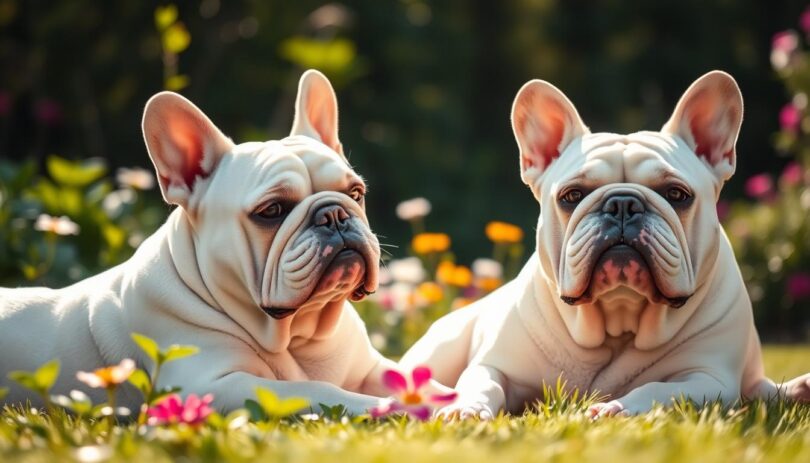What if the perfect companion dog combined rare beauty with unwavering loyalty? Meet the French White Bulldog—a striking variation of one of America’s most beloved breeds. With their snow-like coats and signature charm, these dogs turn heads while offering the same playful, affectionate traits as their classic counterparts.
Though they share the breed’s trademark bat ears and compact build, their ivory fur creates a distinct look. This rarity isn’t just about aesthetics—it also requires specific care to maintain their coat’s brilliance. Yet beneath that unique exterior lies the same spirited personality that makes French Bulldogs ideal pets for city dwellers and families alike.
Owning one means enjoying a loyal companion dog that thrives on human connection. Their adaptability shines in apartments or homes, and their moderate energy levels suit various lifestyles. But what truly sets them apart is how they balance being low-maintenance pals with their eye-catching appearance.
This guide explores everything from their history to practical tips for grooming and health. Whether you’re a seasoned pet owner or considering your first four-legged friend, you’ll discover how to nurture a fulfilling life with these extraordinary canines. Ready to uncover what makes them so special?
Overview of the French White Bulldogs Breed and History
The story of these ivory-coated companions begins not in France, but across the English Channel. In the 1800s, English lacemakers bred miniature bulldogs as lap warmers during long workdays. When industrialization forced many to relocate to Normandy, their beloved pets became favorites among Parisian artists and socialites.
From Workshops to Worldwide Fame
French breeders refined the dogs’ signature bat ears and compact frame, distancing them from their English bulldog ancestors. By 1880, the breed earned its modern name, reflecting its adopted homeland’s cultural influence. These early versions displayed brindle or pied coats—solid white patterns emerged later through selective breeding.
Color Evolution and Modern Standards
Post-1950s, breeders began prioritizing diverse coat colors while maintaining health-focused practices. The American Kennel Club now recognizes white as standard but prohibits merle patterns due to associated health risks. Responsible breeders prioritize genetic testing to ensure vibrant coats don’t compromise wellbeing.
Understanding this heritage helps owners appreciate their pet’s unique needs. Proper care for these dogs involves understanding their unique needs, similar to guidelines for their black-coated counterparts. Today’s standards balance aesthetic appeal with ethical breeding—a legacy shaped by centuries of cultural exchange.
Understanding the Distinct Traits of French White Bulldogs
With a coat as pure as fresh snow and eyes full of expression, the French White Bulldog is a breed apart. These compact companions stand out not just for their striking looks but also for their heartwarming personalities. Let’s explore what makes them truly unique.
Physical Characteristics: Coat, Ears, and Eyes
The most noticeable feature? Their luminous coat, which lacks the darker pigments found in standard Frenchies. This ivory fur requires gentle grooming to prevent skin irritation. Their iconic bat-like ears frame expressive, rounded eyes that often appear darker against their pale faces.
Compared to brindle or pied counterparts, these dogs have less natural sun protection. Regular vet checks help maintain ear health and vision. Their compact build remains consistent across color variations, but the snowy coat demands extra UV protection during outdoor activities.
Temperament and Personality Insights
Beneath that eye-catching exterior lies a playful spirit with moderate energy levels. These dogs thrive on human interaction, often following owners from room to room. They’re social butterflies who enjoy meeting new people but don’t require constant stimulation.
Their easygoing nature makes them ideal for apartment living. While they love playtime, they’re equally content lounging on the couch. This balance of affection and adaptability explains why many consider them perfect companion animals for diverse households.
Health Considerations and Preventing Common Issues
Caring for a rare-coated companion requires extra attention to their unique biological needs. Light pigmentation in certain dogs can make them more prone to specific conditions, but proactive care minimizes risks effectively.
Identifying Potential Skin, Eye, and Ear Problems
Skin sensitivities often top the list of concerns. Less melanin increases sunburn risks and may lead to dermatitis. Watch for redness between skin folds or excessive scratching.
Eye conditions like cherry eye or corneal ulcers occur more frequently in this dog breed. Regular cleaning with vet-approved wipes helps prevent tear stains and infections. Their iconic upright ears also trap moisture, making weekly inspections essential to catch early signs of bacterial growth.
Tips for Regular Vet Check-ups and Preventative Care
Schedule bi-annual vet visits—even if your pet seems healthy. These appointments help detect silent issues like allergies or joint dysplasia. Bloodwork and genetic screenings are particularly valuable for bulldog health management.
Experts recommend UV-protective clothing for outdoor activities and hypoallergenic diets to support skin health. Keep a symptom journal to track changes in energy levels or eating habits. Early intervention often transforms minor issues into manageable ones.
Expert Grooming and Daily Care Practices
Maintaining the health and appearance of pale-coated companions requires specialized strategies. Their delicate skin and unique biological needs demand routines that balance cleanliness with protection. Let’s explore practical methods to keep these dogs thriving.
Gentle Techniques for Sensitive Skin Maintenance
Start with a soft-bristle brush to remove loose hair without irritating the skin. Bathe every 3-4 weeks using oatmeal-based shampoos—harsh chemicals strip natural oils. Always dry skin folds thoroughly to prevent moisture-related rashes.
For tear stains, apply vet-recommended wipes twice daily. Choose sunscreen sprays specifically formulated for dogs before outdoor activities. Trim nails monthly to avoid posture issues that could strain joints.
Nutrition and Activity for Optimal Wellness
Feed high-quality kibble with omega fatty acids to support coat health. Measure portions carefully—these dogs need 25-30 calories per pound daily to maintain a healthy weight. Avoid common allergens like corn or soy.
Schedule two 15-minute walks daily to support cardiovascular health. Use puzzle toys for mental stimulation during indoor play. Combine these steps into a consistent routine—morning grooming, midday walks, and evening feeding—to create stability.
How to Guide for Training Your French White Bulldogs
Building a strong bond with your pale-coated companion starts with positive reinforcement and patience. These intelligent dogs respond best to short, engaging sessions that align with their playful personality traits. Consistency and timing are key—even 10-minute daily drills create lasting habits.
Basic Commands and Obedience Techniques
Start with foundational cues like “sit” and “stay” using high-value treats. Professional trainers recommend clicker training for clear communication. Reward immediately after desired actions to reinforce connections.
For stubborn moments, redirect attention with toys instead of punishment. Many Frenchie owners find success with hand signals paired with verbal commands. Keep sessions upbeat—end on a positive note to maintain enthusiasm.
Socialization Strategies for Family Integration
Introduce new people and pets gradually in controlled environments. Carry treats during walks to create positive associations with strangers. Puppy socialization classes work wonders for building confidence.
Practice handling exercises daily—touch paws and ears gently while offering praise. This reduces stress during vet visits. For comprehensive guidance, explore our expert puppy training advice tailored to sensitive breeds.
Remember—every interaction shapes behavior. Celebrate small victories, and adapt methods to your dog’s unique personality traits. With time and dedication, you’ll nurture a well-adjusted companion who thrives in any setting.
Understanding Genetic Factors and Coat Color Variations
Behind every coat color lies a genetic story that shapes both appearance and health. While cream and brindle patterns catch the eye, they often signal specific biological traits. Responsible ownership starts with understanding how DNA influences these beloved companions.
Exploring Albinism, Leucism, and Merle Patterns
True albinism is rare in this breed. It causes pink skin and light-sensitive eyes due to a complete lack of pigment. Leucism, more common in pale-coated dogs, reduces but doesn’t eliminate melanin—resulting in white fur with normal eye color.
Merle patterns create mottled coats through a dominant gene. Breeding two merle dogs risks “double merle” puppies with high rates of deafness and vision issues. Reputable clubs like the AKC prohibit merle registration due to these health concerns.
Managing Genetic Health Risks Through Informed Breeding
Ethical breeders use DNA testing to avoid pairing dogs with incompatible genes. They prioritize lineage tracking to reduce risks of skin conditions or vision problems linked to certain hues. Ask breeders for OFA certifications and genetic screening reports.
While cream and brindle coats remain popular, informed choices ensure vibrant colors don’t compromise wellbeing. Always verify a puppy’s ancestry spans at least three generations without merle or albino traits. This approach helps maintain both beauty and breed health.
Choosing a Reputable Breeder and Responsible Ownership
Your journey with a new four-legged friend begins with choosing someone who values breed integrity. Ethical breeders prioritize health, temperament, and adherence to established guidelines. They serve as partners in ensuring puppies thrive as happy, well-adjusted companions.
Questions to Ask Potential Breeders
Start by inquiring about health screenings for genetic conditions like hip dysplasia or breathing issues. Reputable providers will share OFA certifications and DNA test results. Ask to meet the puppy’s parents—this reveals temperament and physical traits.
Request details about socialization practices. Puppies raised in home environments often adapt better to family life. Confirm they follow breed-specific nutrition plans and vaccination schedules.
Evaluating Certifications and Standards
Look for AKC-registered breeders who participate in health initiatives. Check if they belong to national breed clubs—these groups enforce strict ethical codes. Avoid sellers offering rare colors at premium prices, as this often signals profit-focused practices.
Visit breeding facilities personally. Clean spaces and transparent operations indicate professionalism. Responsible breeders will ask you questions too—they care where their puppies live.
Ownership extends beyond adoption. Commit to regular vet visits and proper training. By supporting ethical practices, you help preserve the breed’s future while gaining a loyal companion.
Tailoring Your Home Environment for Your French White Bulldogs
A well-designed space enhances your pet's quality of life while addressing their unique biological needs. Start by evaluating your home through their perspective—considering energy levels, sensitivity to temperature, and play preferences.
Indoor Safety and Engagement Strategies
Create designated zones with soft bedding and chew-resistant toys. For smaller breeds, choose low-profile furniture that matches their size—ramps help access couches safely. Rotate puzzle feeders weekly to stimulate their curious nature.
Avoid loose wires or small objects that might tempt exploration. Use baby gates to block hazardous areas like staircases. Non-slip rugs prevent slips on hardwood floors, especially for fawn-colored companions with sensitive joints.
Sun Protection and Outdoor Safety
Schedule walks during cooler morning or evening hours. Install shaded areas in yards using UV-blocking canopies. Apply pet-safe sunscreen to exposed skin before outdoor play.
Provide a shallow water dish for hydration during activities. Monitor for signs of overheating, like excessive panting—a common issue in lighter-coated dogs. Always have a cool retreat available for quick breaks.
Choose toys proportionate to their size to prevent choking hazards. Regularly inspect outdoor spaces for sharp objects or toxic plants. With these adjustments, you’ll create a nurturing environment that supports their health and enriches daily life.
Final Reflections on Embracing Life with French White Bulldogs
French White Bulldogs bring a special kind of magic to homes, blending elegance with heartwarming companionship. These distinctive dogs carry a rich history, from lacemakers’ laps to becoming beloved family members. Their unique needs—from sun-safe outings to skin-friendly grooming—highlight the importance of tailored care.
By prioritizing health checks and positive training, owners help their pets thrive. Creating safe indoor spaces and choosing responsible breeders ensures long-term wellbeing. The result? A confident, joyful companion who becomes integral to family life.
While their care requires dedication, the rewards of loyalty and laughter make every effort worthwhile. For those ready to embrace both challenges and cuddles, French White Bulldogs offer a journey filled with unforgettable moments.
FAQ
Are white-coated bulldogs more prone to health issues?
Lighter coats linked to leucism or albinism may increase sensitivity to sun exposure and skin conditions. Regular vet visits help monitor eye, ear, and dermatological health common in the breed.
How do I find ethical breeders for this unique color variation?
Reputable breeders provide genetic testing records, certifications, and transparent health histories. Ask about parentage, merle pattern avoidance, and adherence to AKC standards for responsible breeding practices.
Why do some have entirely white coats?
The pale coloration results from specific genes like leucism or piebald patterns—not albinism. Breeders prioritize maintaining pigment-rich eye rims and noses to reduce sunburn risks.










Leave a Comment